Business Information Systems: SSL Case Study Report
VerifiedAdded on 2023/06/03
|9
|2893
|182
Case Study
AI Summary
This case study analyzes Security Services Limited (SSL), a UK-based security services provider, examining its operations, information system (IS) strategy, and potential for future growth. The report delves into SSL's four divisions: Private Transport, Business Security, Domestic Security, and Home Office Services, assessing their current IS infrastructure, which is largely manual and fragmented. It explores portfolio analysis, highlighting services like armored transport and business security, and evaluates strategic potential by proposing a comprehensive IS strategy. This includes upgrading hardware, implementing a centralized MIS solution, enhancing networking capabilities, and centralizing data storage. The report discusses the strategic benefits of this approach, such as improved data visibility, faster reporting, and enhanced service responsiveness. Finally, the case study considers location selection for the IS infrastructure, recommending a centralized approach at the headquarters to minimize costs and streamline operations. The assignment is based on the MITS4001 Business Information Systems course and includes an introduction, portfolio analysis, IS strategy assessment, strategic potential analysis, location selection and conclusions.

Security Services Limited (SSL) - Case Study
Contents
Introduction...........................................................................................................................................2
Portfolio Analysis and Future Investment assessment...........................................................................2
Information System Strategy.................................................................................................................2
Strategic Potential..................................................................................................................................5
Location selection..................................................................................................................................6
Conclusions...........................................................................................................................................7
References.............................................................................................................................................8
1
Contents
Introduction...........................................................................................................................................2
Portfolio Analysis and Future Investment assessment...........................................................................2
Information System Strategy.................................................................................................................2
Strategic Potential..................................................................................................................................5
Location selection..................................................................................................................................6
Conclusions...........................................................................................................................................7
References.............................................................................................................................................8
1
Paraphrase This Document
Need a fresh take? Get an instant paraphrase of this document with our AI Paraphraser
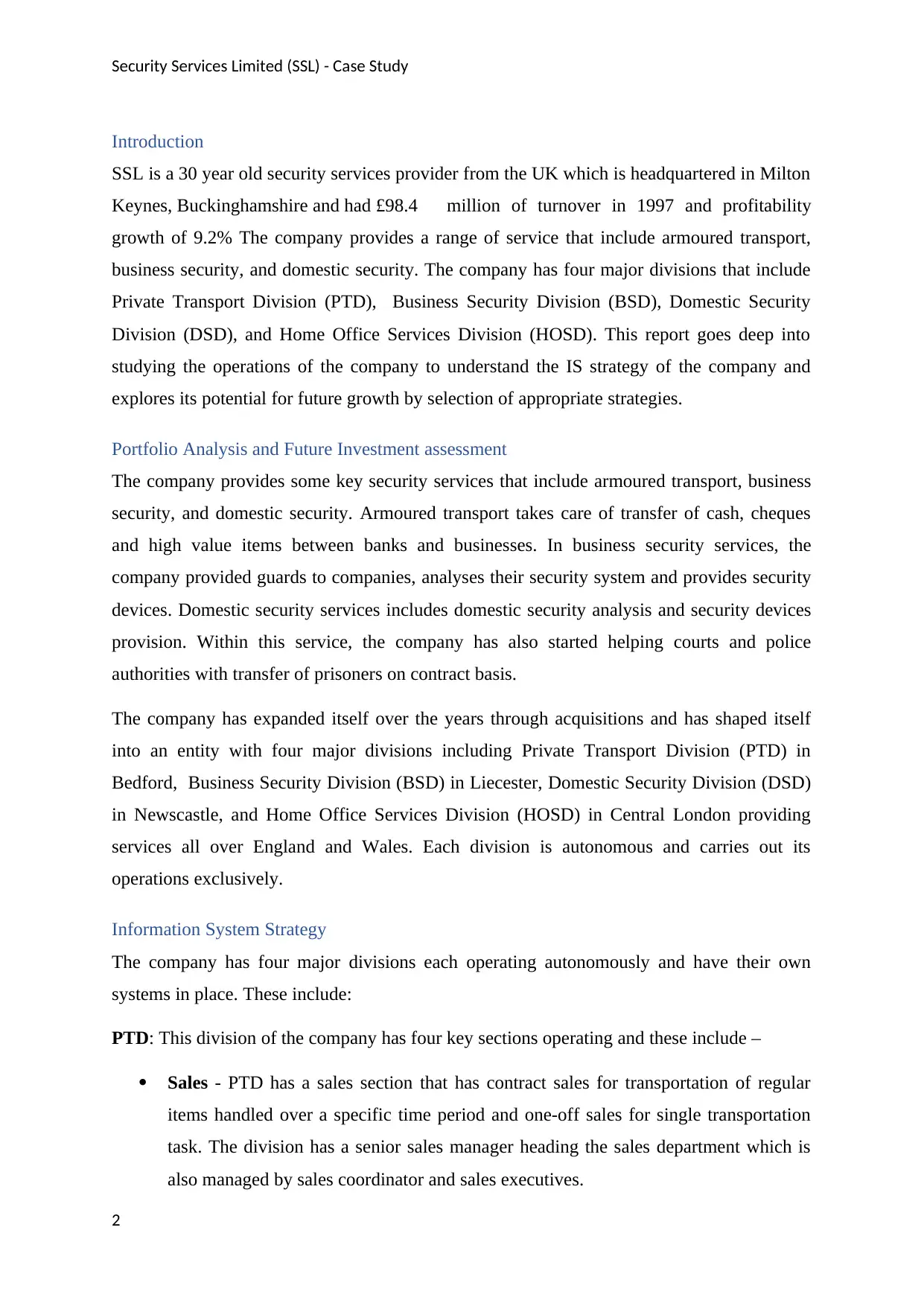
Security Services Limited (SSL) - Case Study
Introduction
SSL is a 30 year old security services provider from the UK which is headquartered in Milton
Keynes, Buckinghamshire and had £98.4 million of turnover in 1997 and profitability
growth of 9.2% The company provides a range of service that include armoured transport,
business security, and domestic security. The company has four major divisions that include
Private Transport Division (PTD), Business Security Division (BSD), Domestic Security
Division (DSD), and Home Office Services Division (HOSD). This report goes deep into
studying the operations of the company to understand the IS strategy of the company and
explores its potential for future growth by selection of appropriate strategies.
Portfolio Analysis and Future Investment assessment
The company provides some key security services that include armoured transport, business
security, and domestic security. Armoured transport takes care of transfer of cash, cheques
and high value items between banks and businesses. In business security services, the
company provided guards to companies, analyses their security system and provides security
devices. Domestic security services includes domestic security analysis and security devices
provision. Within this service, the company has also started helping courts and police
authorities with transfer of prisoners on contract basis.
The company has expanded itself over the years through acquisitions and has shaped itself
into an entity with four major divisions including Private Transport Division (PTD) in
Bedford, Business Security Division (BSD) in Liecester, Domestic Security Division (DSD)
in Newscastle, and Home Office Services Division (HOSD) in Central London providing
services all over England and Wales. Each division is autonomous and carries out its
operations exclusively.
Information System Strategy
The company has four major divisions each operating autonomously and have their own
systems in place. These include:
PTD: This division of the company has four key sections operating and these include –
Sales - PTD has a sales section that has contract sales for transportation of regular
items handled over a specific time period and one-off sales for single transportation
task. The division has a senior sales manager heading the sales department which is
also managed by sales coordinator and sales executives.
2
Introduction
SSL is a 30 year old security services provider from the UK which is headquartered in Milton
Keynes, Buckinghamshire and had £98.4 million of turnover in 1997 and profitability
growth of 9.2% The company provides a range of service that include armoured transport,
business security, and domestic security. The company has four major divisions that include
Private Transport Division (PTD), Business Security Division (BSD), Domestic Security
Division (DSD), and Home Office Services Division (HOSD). This report goes deep into
studying the operations of the company to understand the IS strategy of the company and
explores its potential for future growth by selection of appropriate strategies.
Portfolio Analysis and Future Investment assessment
The company provides some key security services that include armoured transport, business
security, and domestic security. Armoured transport takes care of transfer of cash, cheques
and high value items between banks and businesses. In business security services, the
company provided guards to companies, analyses their security system and provides security
devices. Domestic security services includes domestic security analysis and security devices
provision. Within this service, the company has also started helping courts and police
authorities with transfer of prisoners on contract basis.
The company has expanded itself over the years through acquisitions and has shaped itself
into an entity with four major divisions including Private Transport Division (PTD) in
Bedford, Business Security Division (BSD) in Liecester, Domestic Security Division (DSD)
in Newscastle, and Home Office Services Division (HOSD) in Central London providing
services all over England and Wales. Each division is autonomous and carries out its
operations exclusively.
Information System Strategy
The company has four major divisions each operating autonomously and have their own
systems in place. These include:
PTD: This division of the company has four key sections operating and these include –
Sales - PTD has a sales section that has contract sales for transportation of regular
items handled over a specific time period and one-off sales for single transportation
task. The division has a senior sales manager heading the sales department which is
also managed by sales coordinator and sales executives.
2
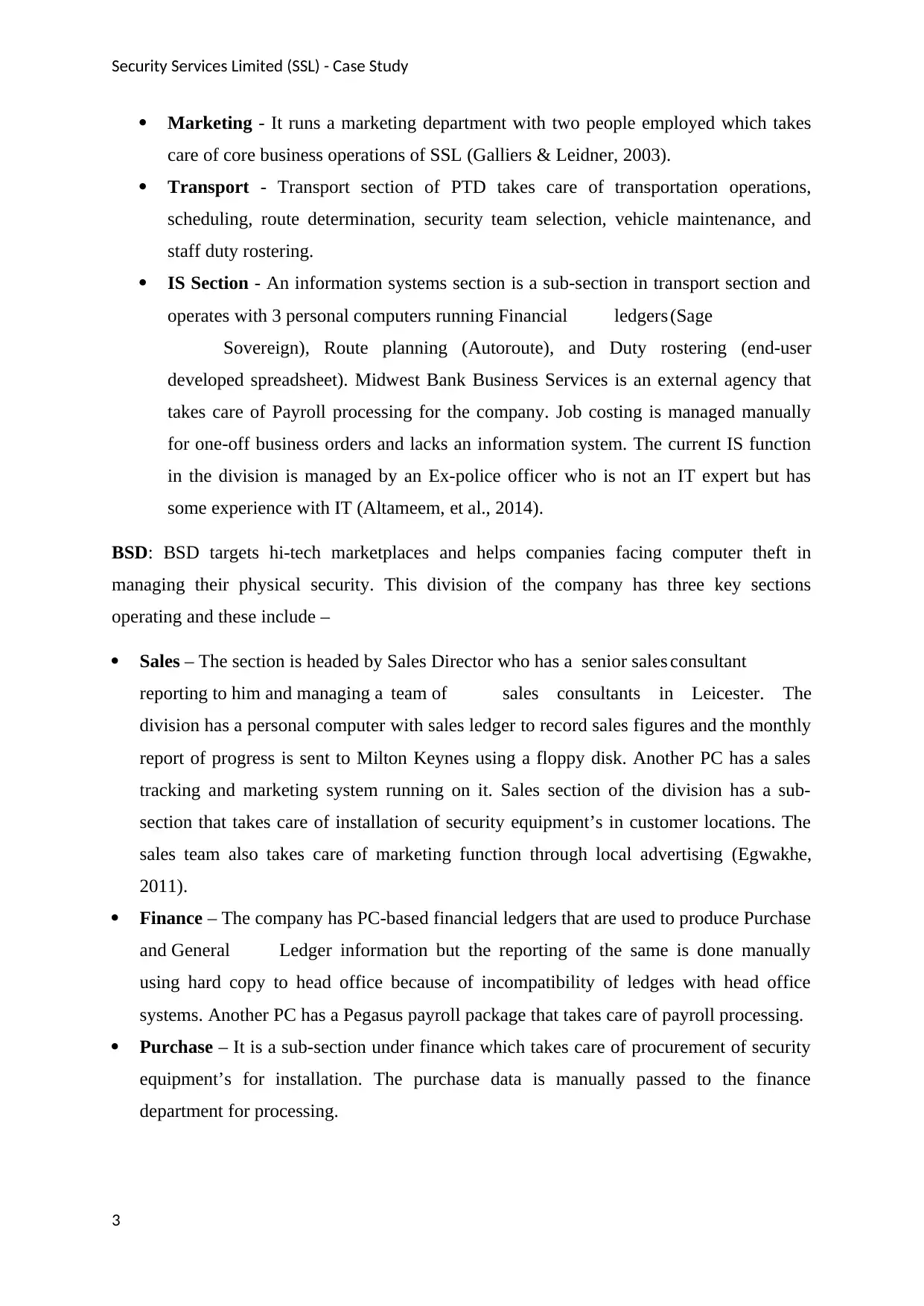
Security Services Limited (SSL) - Case Study
Marketing - It runs a marketing department with two people employed which takes
care of core business operations of SSL (Galliers & Leidner, 2003).
Transport - Transport section of PTD takes care of transportation operations,
scheduling, route determination, security team selection, vehicle maintenance, and
staff duty rostering.
IS Section - An information systems section is a sub-section in transport section and
operates with 3 personal computers running Financial ledgers (Sage
Sovereign), Route planning (Autoroute), and Duty rostering (end-user
developed spreadsheet). Midwest Bank Business Services is an external agency that
takes care of Payroll processing for the company. Job costing is managed manually
for one-off business orders and lacks an information system. The current IS function
in the division is managed by an Ex-police officer who is not an IT expert but has
some experience with IT (Altameem, et al., 2014).
BSD: BSD targets hi-tech marketplaces and helps companies facing computer theft in
managing their physical security. This division of the company has three key sections
operating and these include –
Sales – The section is headed by Sales Director who has a senior sales consultant
reporting to him and managing a team of sales consultants in Leicester. The
division has a personal computer with sales ledger to record sales figures and the monthly
report of progress is sent to Milton Keynes using a floppy disk. Another PC has a sales
tracking and marketing system running on it. Sales section of the division has a sub-
section that takes care of installation of security equipment’s in customer locations. The
sales team also takes care of marketing function through local advertising (Egwakhe,
2011).
Finance – The company has PC-based financial ledgers that are used to produce Purchase
and General Ledger information but the reporting of the same is done manually
using hard copy to head office because of incompatibility of ledges with head office
systems. Another PC has a Pegasus payroll package that takes care of payroll processing.
Purchase – It is a sub-section under finance which takes care of procurement of security
equipment’s for installation. The purchase data is manually passed to the finance
department for processing.
3
Marketing - It runs a marketing department with two people employed which takes
care of core business operations of SSL (Galliers & Leidner, 2003).
Transport - Transport section of PTD takes care of transportation operations,
scheduling, route determination, security team selection, vehicle maintenance, and
staff duty rostering.
IS Section - An information systems section is a sub-section in transport section and
operates with 3 personal computers running Financial ledgers (Sage
Sovereign), Route planning (Autoroute), and Duty rostering (end-user
developed spreadsheet). Midwest Bank Business Services is an external agency that
takes care of Payroll processing for the company. Job costing is managed manually
for one-off business orders and lacks an information system. The current IS function
in the division is managed by an Ex-police officer who is not an IT expert but has
some experience with IT (Altameem, et al., 2014).
BSD: BSD targets hi-tech marketplaces and helps companies facing computer theft in
managing their physical security. This division of the company has three key sections
operating and these include –
Sales – The section is headed by Sales Director who has a senior sales consultant
reporting to him and managing a team of sales consultants in Leicester. The
division has a personal computer with sales ledger to record sales figures and the monthly
report of progress is sent to Milton Keynes using a floppy disk. Another PC has a sales
tracking and marketing system running on it. Sales section of the division has a sub-
section that takes care of installation of security equipment’s in customer locations. The
sales team also takes care of marketing function through local advertising (Egwakhe,
2011).
Finance – The company has PC-based financial ledgers that are used to produce Purchase
and General Ledger information but the reporting of the same is done manually
using hard copy to head office because of incompatibility of ledges with head office
systems. Another PC has a Pegasus payroll package that takes care of payroll processing.
Purchase – It is a sub-section under finance which takes care of procurement of security
equipment’s for installation. The purchase data is manually passed to the finance
department for processing.
3
⊘ This is a preview!⊘
Do you want full access?
Subscribe today to unlock all pages.

Trusted by 1+ million students worldwide
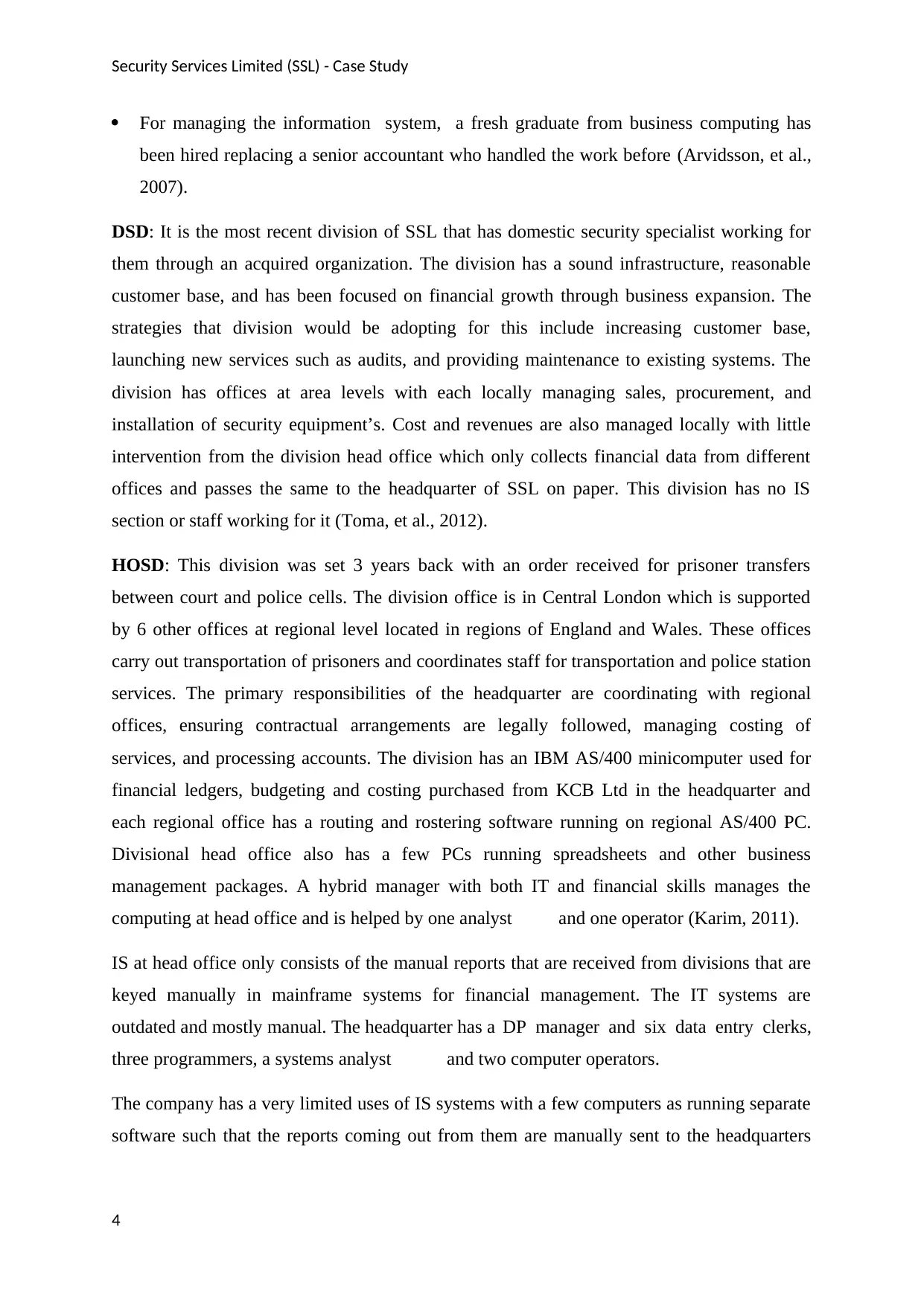
Security Services Limited (SSL) - Case Study
For managing the information system, a fresh graduate from business computing has
been hired replacing a senior accountant who handled the work before (Arvidsson, et al.,
2007).
DSD: It is the most recent division of SSL that has domestic security specialist working for
them through an acquired organization. The division has a sound infrastructure, reasonable
customer base, and has been focused on financial growth through business expansion. The
strategies that division would be adopting for this include increasing customer base,
launching new services such as audits, and providing maintenance to existing systems. The
division has offices at area levels with each locally managing sales, procurement, and
installation of security equipment’s. Cost and revenues are also managed locally with little
intervention from the division head office which only collects financial data from different
offices and passes the same to the headquarter of SSL on paper. This division has no IS
section or staff working for it (Toma, et al., 2012).
HOSD: This division was set 3 years back with an order received for prisoner transfers
between court and police cells. The division office is in Central London which is supported
by 6 other offices at regional level located in regions of England and Wales. These offices
carry out transportation of prisoners and coordinates staff for transportation and police station
services. The primary responsibilities of the headquarter are coordinating with regional
offices, ensuring contractual arrangements are legally followed, managing costing of
services, and processing accounts. The division has an IBM AS/400 minicomputer used for
financial ledgers, budgeting and costing purchased from KCB Ltd in the headquarter and
each regional office has a routing and rostering software running on regional AS/400 PC.
Divisional head office also has a few PCs running spreadsheets and other business
management packages. A hybrid manager with both IT and financial skills manages the
computing at head office and is helped by one analyst and one operator (Karim, 2011).
IS at head office only consists of the manual reports that are received from divisions that are
keyed manually in mainframe systems for financial management. The IT systems are
outdated and mostly manual. The headquarter has a DP manager and six data entry clerks,
three programmers, a systems analyst and two computer operators.
The company has a very limited uses of IS systems with a few computers as running separate
software such that the reports coming out from them are manually sent to the headquarters
4
For managing the information system, a fresh graduate from business computing has
been hired replacing a senior accountant who handled the work before (Arvidsson, et al.,
2007).
DSD: It is the most recent division of SSL that has domestic security specialist working for
them through an acquired organization. The division has a sound infrastructure, reasonable
customer base, and has been focused on financial growth through business expansion. The
strategies that division would be adopting for this include increasing customer base,
launching new services such as audits, and providing maintenance to existing systems. The
division has offices at area levels with each locally managing sales, procurement, and
installation of security equipment’s. Cost and revenues are also managed locally with little
intervention from the division head office which only collects financial data from different
offices and passes the same to the headquarter of SSL on paper. This division has no IS
section or staff working for it (Toma, et al., 2012).
HOSD: This division was set 3 years back with an order received for prisoner transfers
between court and police cells. The division office is in Central London which is supported
by 6 other offices at regional level located in regions of England and Wales. These offices
carry out transportation of prisoners and coordinates staff for transportation and police station
services. The primary responsibilities of the headquarter are coordinating with regional
offices, ensuring contractual arrangements are legally followed, managing costing of
services, and processing accounts. The division has an IBM AS/400 minicomputer used for
financial ledgers, budgeting and costing purchased from KCB Ltd in the headquarter and
each regional office has a routing and rostering software running on regional AS/400 PC.
Divisional head office also has a few PCs running spreadsheets and other business
management packages. A hybrid manager with both IT and financial skills manages the
computing at head office and is helped by one analyst and one operator (Karim, 2011).
IS at head office only consists of the manual reports that are received from divisions that are
keyed manually in mainframe systems for financial management. The IT systems are
outdated and mostly manual. The headquarter has a DP manager and six data entry clerks,
three programmers, a systems analyst and two computer operators.
The company has a very limited uses of IS systems with a few computers as running separate
software such that the reports coming out from them are manually sent to the headquarters
4
Paraphrase This Document
Need a fresh take? Get an instant paraphrase of this document with our AI Paraphraser
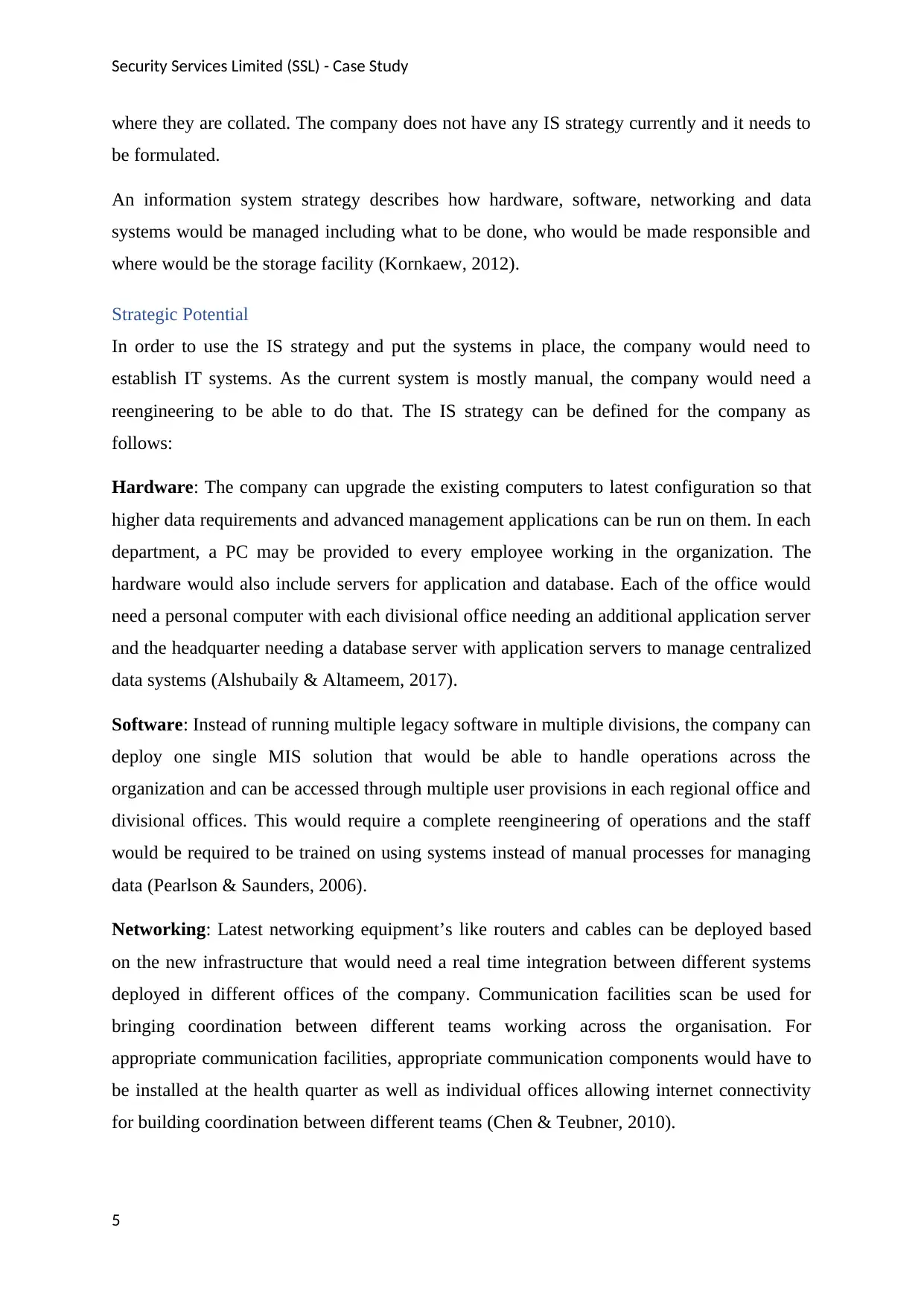
Security Services Limited (SSL) - Case Study
where they are collated. The company does not have any IS strategy currently and it needs to
be formulated.
An information system strategy describes how hardware, software, networking and data
systems would be managed including what to be done, who would be made responsible and
where would be the storage facility (Kornkaew, 2012).
Strategic Potential
In order to use the IS strategy and put the systems in place, the company would need to
establish IT systems. As the current system is mostly manual, the company would need a
reengineering to be able to do that. The IS strategy can be defined for the company as
follows:
Hardware: The company can upgrade the existing computers to latest configuration so that
higher data requirements and advanced management applications can be run on them. In each
department, a PC may be provided to every employee working in the organization. The
hardware would also include servers for application and database. Each of the office would
need a personal computer with each divisional office needing an additional application server
and the headquarter needing a database server with application servers to manage centralized
data systems (Alshubaily & Altameem, 2017).
Software: Instead of running multiple legacy software in multiple divisions, the company can
deploy one single MIS solution that would be able to handle operations across the
organization and can be accessed through multiple user provisions in each regional office and
divisional offices. This would require a complete reengineering of operations and the staff
would be required to be trained on using systems instead of manual processes for managing
data (Pearlson & Saunders, 2006).
Networking: Latest networking equipment’s like routers and cables can be deployed based
on the new infrastructure that would need a real time integration between different systems
deployed in different offices of the company. Communication facilities scan be used for
bringing coordination between different teams working across the organisation. For
appropriate communication facilities, appropriate communication components would have to
be installed at the health quarter as well as individual offices allowing internet connectivity
for building coordination between different teams (Chen & Teubner, 2010).
5
where they are collated. The company does not have any IS strategy currently and it needs to
be formulated.
An information system strategy describes how hardware, software, networking and data
systems would be managed including what to be done, who would be made responsible and
where would be the storage facility (Kornkaew, 2012).
Strategic Potential
In order to use the IS strategy and put the systems in place, the company would need to
establish IT systems. As the current system is mostly manual, the company would need a
reengineering to be able to do that. The IS strategy can be defined for the company as
follows:
Hardware: The company can upgrade the existing computers to latest configuration so that
higher data requirements and advanced management applications can be run on them. In each
department, a PC may be provided to every employee working in the organization. The
hardware would also include servers for application and database. Each of the office would
need a personal computer with each divisional office needing an additional application server
and the headquarter needing a database server with application servers to manage centralized
data systems (Alshubaily & Altameem, 2017).
Software: Instead of running multiple legacy software in multiple divisions, the company can
deploy one single MIS solution that would be able to handle operations across the
organization and can be accessed through multiple user provisions in each regional office and
divisional offices. This would require a complete reengineering of operations and the staff
would be required to be trained on using systems instead of manual processes for managing
data (Pearlson & Saunders, 2006).
Networking: Latest networking equipment’s like routers and cables can be deployed based
on the new infrastructure that would need a real time integration between different systems
deployed in different offices of the company. Communication facilities scan be used for
bringing coordination between different teams working across the organisation. For
appropriate communication facilities, appropriate communication components would have to
be installed at the health quarter as well as individual offices allowing internet connectivity
for building coordination between different teams (Chen & Teubner, 2010).
5
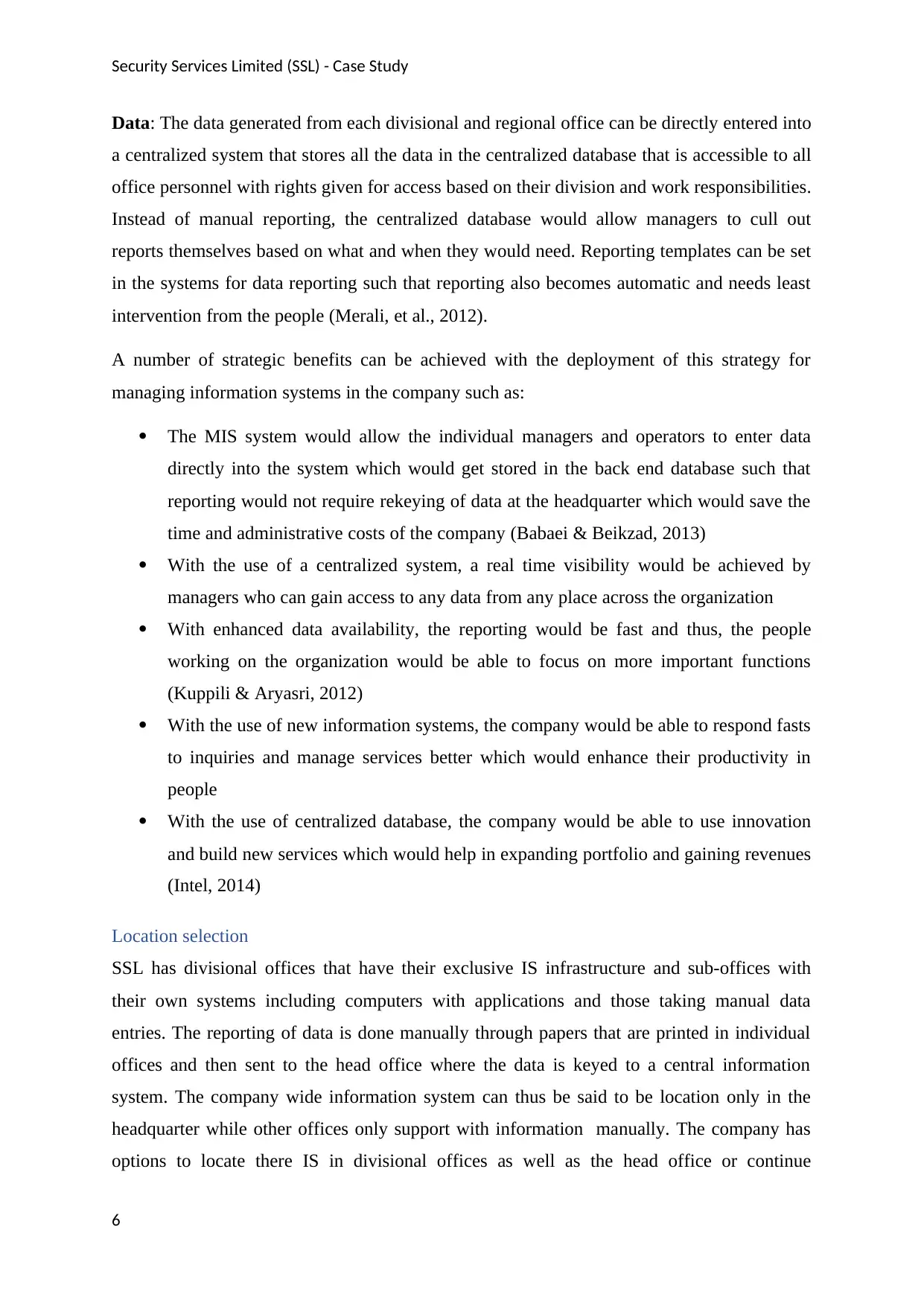
Security Services Limited (SSL) - Case Study
Data: The data generated from each divisional and regional office can be directly entered into
a centralized system that stores all the data in the centralized database that is accessible to all
office personnel with rights given for access based on their division and work responsibilities.
Instead of manual reporting, the centralized database would allow managers to cull out
reports themselves based on what and when they would need. Reporting templates can be set
in the systems for data reporting such that reporting also becomes automatic and needs least
intervention from the people (Merali, et al., 2012).
A number of strategic benefits can be achieved with the deployment of this strategy for
managing information systems in the company such as:
The MIS system would allow the individual managers and operators to enter data
directly into the system which would get stored in the back end database such that
reporting would not require rekeying of data at the headquarter which would save the
time and administrative costs of the company (Babaei & Beikzad, 2013)
With the use of a centralized system, a real time visibility would be achieved by
managers who can gain access to any data from any place across the organization
With enhanced data availability, the reporting would be fast and thus, the people
working on the organization would be able to focus on more important functions
(Kuppili & Aryasri, 2012)
With the use of new information systems, the company would be able to respond fasts
to inquiries and manage services better which would enhance their productivity in
people
With the use of centralized database, the company would be able to use innovation
and build new services which would help in expanding portfolio and gaining revenues
(Intel, 2014)
Location selection
SSL has divisional offices that have their exclusive IS infrastructure and sub-offices with
their own systems including computers with applications and those taking manual data
entries. The reporting of data is done manually through papers that are printed in individual
offices and then sent to the head office where the data is keyed to a central information
system. The company wide information system can thus be said to be location only in the
headquarter while other offices only support with information manually. The company has
options to locate there IS in divisional offices as well as the head office or continue
6
Data: The data generated from each divisional and regional office can be directly entered into
a centralized system that stores all the data in the centralized database that is accessible to all
office personnel with rights given for access based on their division and work responsibilities.
Instead of manual reporting, the centralized database would allow managers to cull out
reports themselves based on what and when they would need. Reporting templates can be set
in the systems for data reporting such that reporting also becomes automatic and needs least
intervention from the people (Merali, et al., 2012).
A number of strategic benefits can be achieved with the deployment of this strategy for
managing information systems in the company such as:
The MIS system would allow the individual managers and operators to enter data
directly into the system which would get stored in the back end database such that
reporting would not require rekeying of data at the headquarter which would save the
time and administrative costs of the company (Babaei & Beikzad, 2013)
With the use of a centralized system, a real time visibility would be achieved by
managers who can gain access to any data from any place across the organization
With enhanced data availability, the reporting would be fast and thus, the people
working on the organization would be able to focus on more important functions
(Kuppili & Aryasri, 2012)
With the use of new information systems, the company would be able to respond fasts
to inquiries and manage services better which would enhance their productivity in
people
With the use of centralized database, the company would be able to use innovation
and build new services which would help in expanding portfolio and gaining revenues
(Intel, 2014)
Location selection
SSL has divisional offices that have their exclusive IS infrastructure and sub-offices with
their own systems including computers with applications and those taking manual data
entries. The reporting of data is done manually through papers that are printed in individual
offices and then sent to the head office where the data is keyed to a central information
system. The company wide information system can thus be said to be location only in the
headquarter while other offices only support with information manually. The company has
options to locate there IS in divisional offices as well as the head office or continue
6
⊘ This is a preview!⊘
Do you want full access?
Subscribe today to unlock all pages.

Trusted by 1+ million students worldwide
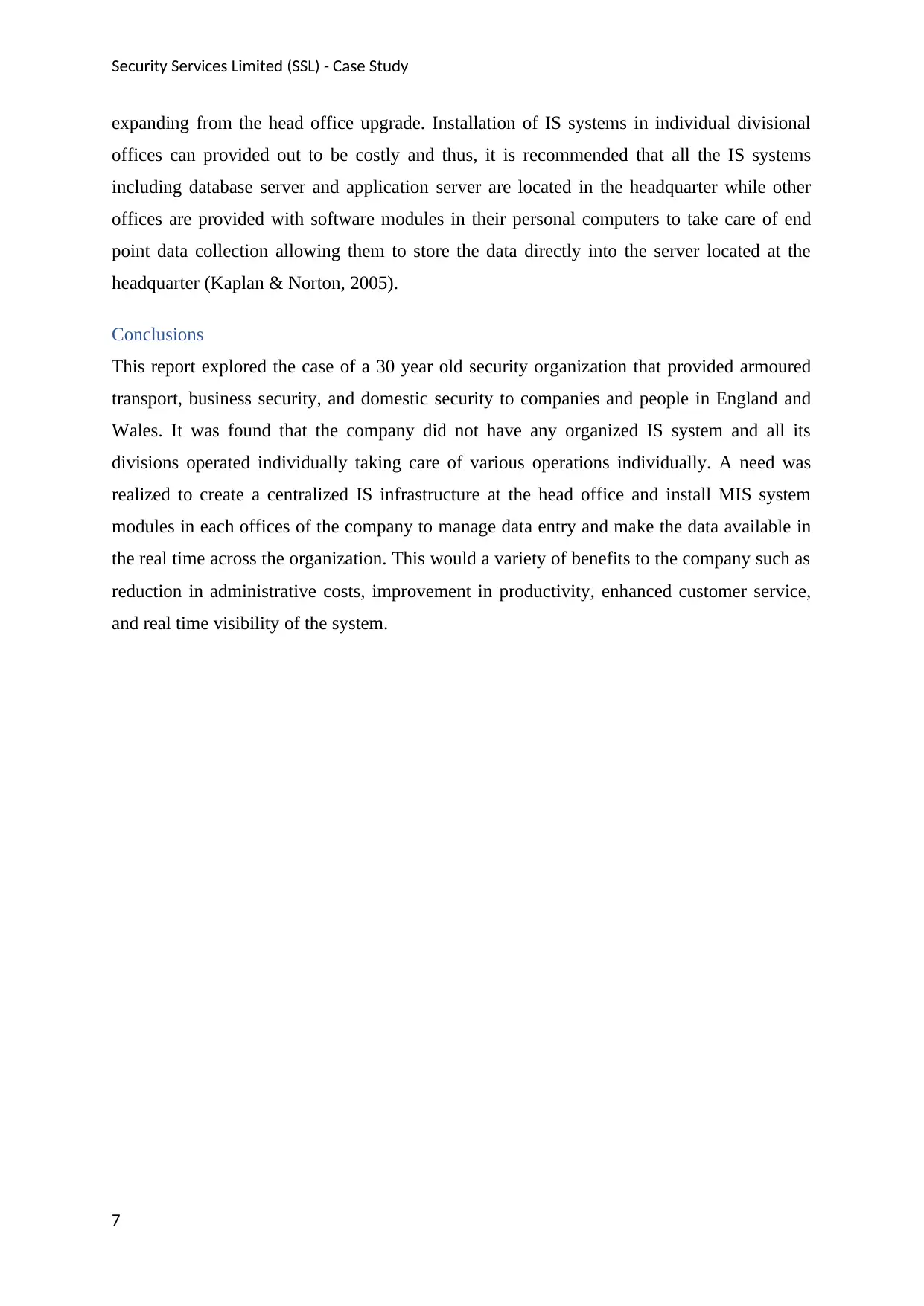
Security Services Limited (SSL) - Case Study
expanding from the head office upgrade. Installation of IS systems in individual divisional
offices can provided out to be costly and thus, it is recommended that all the IS systems
including database server and application server are located in the headquarter while other
offices are provided with software modules in their personal computers to take care of end
point data collection allowing them to store the data directly into the server located at the
headquarter (Kaplan & Norton, 2005).
Conclusions
This report explored the case of a 30 year old security organization that provided armoured
transport, business security, and domestic security to companies and people in England and
Wales. It was found that the company did not have any organized IS system and all its
divisions operated individually taking care of various operations individually. A need was
realized to create a centralized IS infrastructure at the head office and install MIS system
modules in each offices of the company to manage data entry and make the data available in
the real time across the organization. This would a variety of benefits to the company such as
reduction in administrative costs, improvement in productivity, enhanced customer service,
and real time visibility of the system.
7
expanding from the head office upgrade. Installation of IS systems in individual divisional
offices can provided out to be costly and thus, it is recommended that all the IS systems
including database server and application server are located in the headquarter while other
offices are provided with software modules in their personal computers to take care of end
point data collection allowing them to store the data directly into the server located at the
headquarter (Kaplan & Norton, 2005).
Conclusions
This report explored the case of a 30 year old security organization that provided armoured
transport, business security, and domestic security to companies and people in England and
Wales. It was found that the company did not have any organized IS system and all its
divisions operated individually taking care of various operations individually. A need was
realized to create a centralized IS infrastructure at the head office and install MIS system
modules in each offices of the company to manage data entry and make the data available in
the real time across the organization. This would a variety of benefits to the company such as
reduction in administrative costs, improvement in productivity, enhanced customer service,
and real time visibility of the system.
7
Paraphrase This Document
Need a fresh take? Get an instant paraphrase of this document with our AI Paraphraser
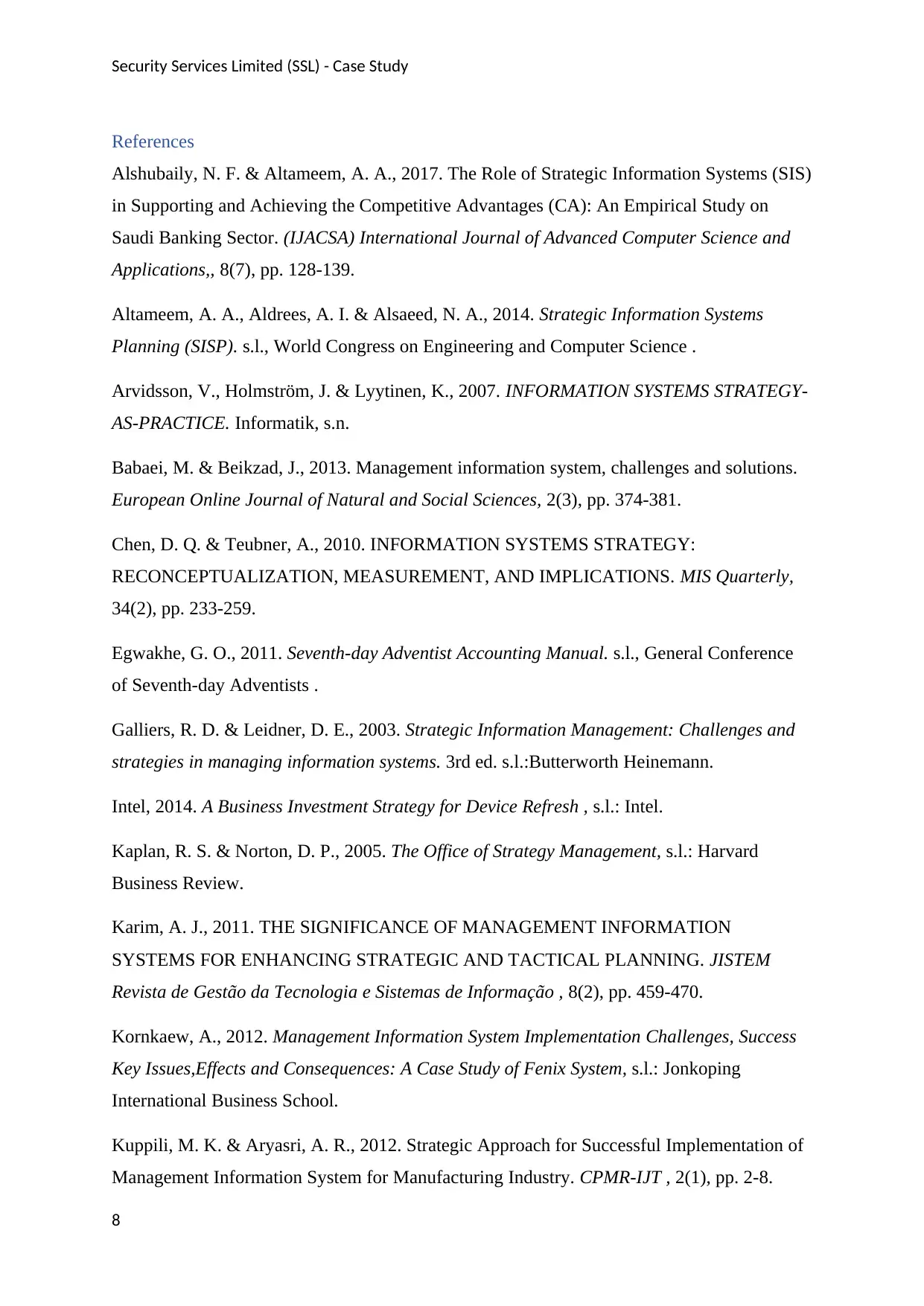
Security Services Limited (SSL) - Case Study
References
Alshubaily, N. F. & Altameem, A. A., 2017. The Role of Strategic Information Systems (SIS)
in Supporting and Achieving the Competitive Advantages (CA): An Empirical Study on
Saudi Banking Sector. (IJACSA) International Journal of Advanced Computer Science and
Applications,, 8(7), pp. 128-139.
Altameem, A. A., Aldrees, A. I. & Alsaeed, N. A., 2014. Strategic Information Systems
Planning (SISP). s.l., World Congress on Engineering and Computer Science .
Arvidsson, V., Holmström, J. & Lyytinen, K., 2007. INFORMATION SYSTEMS STRATEGY-
AS-PRACTICE. Informatik, s.n.
Babaei, M. & Beikzad, J., 2013. Management information system, challenges and solutions.
European Online Journal of Natural and Social Sciences, 2(3), pp. 374-381.
Chen, D. Q. & Teubner, A., 2010. INFORMATION SYSTEMS STRATEGY:
RECONCEPTUALIZATION, MEASUREMENT, AND IMPLICATIONS. MIS Quarterly,
34(2), pp. 233-259.
Egwakhe, G. O., 2011. Seventh-day Adventist Accounting Manual. s.l., General Conference
of Seventh-day Adventists .
Galliers, R. D. & Leidner, D. E., 2003. Strategic Information Management: Challenges and
strategies in managing information systems. 3rd ed. s.l.:Butterworth Heinemann.
Intel, 2014. A Business Investment Strategy for Device Refresh , s.l.: Intel.
Kaplan, R. S. & Norton, D. P., 2005. The Office of Strategy Management, s.l.: Harvard
Business Review.
Karim, A. J., 2011. THE SIGNIFICANCE OF MANAGEMENT INFORMATION
SYSTEMS FOR ENHANCING STRATEGIC AND TACTICAL PLANNING. JISTEM
Revista de Gestão da Tecnologia e Sistemas de Informação , 8(2), pp. 459-470.
Kornkaew, A., 2012. Management Information System Implementation Challenges, Success
Key Issues,Effects and Consequences: A Case Study of Fenix System, s.l.: Jonkoping
International Business School.
Kuppili, M. K. & Aryasri, A. R., 2012. Strategic Approach for Successful Implementation of
Management Information System for Manufacturing Industry. CPMR-IJT , 2(1), pp. 2-8.
8
References
Alshubaily, N. F. & Altameem, A. A., 2017. The Role of Strategic Information Systems (SIS)
in Supporting and Achieving the Competitive Advantages (CA): An Empirical Study on
Saudi Banking Sector. (IJACSA) International Journal of Advanced Computer Science and
Applications,, 8(7), pp. 128-139.
Altameem, A. A., Aldrees, A. I. & Alsaeed, N. A., 2014. Strategic Information Systems
Planning (SISP). s.l., World Congress on Engineering and Computer Science .
Arvidsson, V., Holmström, J. & Lyytinen, K., 2007. INFORMATION SYSTEMS STRATEGY-
AS-PRACTICE. Informatik, s.n.
Babaei, M. & Beikzad, J., 2013. Management information system, challenges and solutions.
European Online Journal of Natural and Social Sciences, 2(3), pp. 374-381.
Chen, D. Q. & Teubner, A., 2010. INFORMATION SYSTEMS STRATEGY:
RECONCEPTUALIZATION, MEASUREMENT, AND IMPLICATIONS. MIS Quarterly,
34(2), pp. 233-259.
Egwakhe, G. O., 2011. Seventh-day Adventist Accounting Manual. s.l., General Conference
of Seventh-day Adventists .
Galliers, R. D. & Leidner, D. E., 2003. Strategic Information Management: Challenges and
strategies in managing information systems. 3rd ed. s.l.:Butterworth Heinemann.
Intel, 2014. A Business Investment Strategy for Device Refresh , s.l.: Intel.
Kaplan, R. S. & Norton, D. P., 2005. The Office of Strategy Management, s.l.: Harvard
Business Review.
Karim, A. J., 2011. THE SIGNIFICANCE OF MANAGEMENT INFORMATION
SYSTEMS FOR ENHANCING STRATEGIC AND TACTICAL PLANNING. JISTEM
Revista de Gestão da Tecnologia e Sistemas de Informação , 8(2), pp. 459-470.
Kornkaew, A., 2012. Management Information System Implementation Challenges, Success
Key Issues,Effects and Consequences: A Case Study of Fenix System, s.l.: Jonkoping
International Business School.
Kuppili, M. K. & Aryasri, A. R., 2012. Strategic Approach for Successful Implementation of
Management Information System for Manufacturing Industry. CPMR-IJT , 2(1), pp. 2-8.
8

Security Services Limited (SSL) - Case Study
Merali, Y., Papadopoulos, T. & TanveeNadkarnia, 2012. Information systems strategy: Past,
present, future?. The Journal of Strategic Information Systems, 21(2), pp. 125-153.
Pearlson, K. & Saunders, C., 2006. The Information Systems Strategy Triangle, s.l.: Wiley
PUblishers.
Toma, F. et al., 2012. Guide to Practice Management for Small- and Medium-Sized
Practices. 3rd ed. s.l.:International Federation of Accountants .
9
Merali, Y., Papadopoulos, T. & TanveeNadkarnia, 2012. Information systems strategy: Past,
present, future?. The Journal of Strategic Information Systems, 21(2), pp. 125-153.
Pearlson, K. & Saunders, C., 2006. The Information Systems Strategy Triangle, s.l.: Wiley
PUblishers.
Toma, F. et al., 2012. Guide to Practice Management for Small- and Medium-Sized
Practices. 3rd ed. s.l.:International Federation of Accountants .
9
⊘ This is a preview!⊘
Do you want full access?
Subscribe today to unlock all pages.

Trusted by 1+ million students worldwide
1 out of 9
Related Documents
Your All-in-One AI-Powered Toolkit for Academic Success.
+13062052269
info@desklib.com
Available 24*7 on WhatsApp / Email
![[object Object]](/_next/static/media/star-bottom.7253800d.svg)
Unlock your academic potential
Copyright © 2020–2025 A2Z Services. All Rights Reserved. Developed and managed by ZUCOL.

